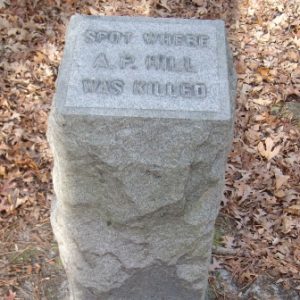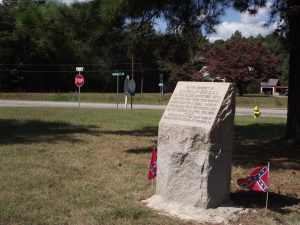ECW Weekender: Spot Where A.P. Hill Was Killed
 It’s a bold claim to set in stone that you are on the exact spot of a historic event. In 1912 the Sons of Confederate Veterans felt confident enough in their research on the death of Lieutenant General Ambrose Powell Hill to make that statement. I’ve recently written a couple articles sharing new accounts about Hill’s death, discoveries I made after devoting a chapter of Dawn of Victory: Breakthrough at Petersburg to the story of the Third Corps commander’s final ride. Everything I’ve found since 2015 has built on that current accepted interpretation. For all I know Corporal John Mauk’s minie ball did strike Hill at the exact location that is claimed, but it can be a tricky place to find.
It’s a bold claim to set in stone that you are on the exact spot of a historic event. In 1912 the Sons of Confederate Veterans felt confident enough in their research on the death of Lieutenant General Ambrose Powell Hill to make that statement. I’ve recently written a couple articles sharing new accounts about Hill’s death, discoveries I made after devoting a chapter of Dawn of Victory: Breakthrough at Petersburg to the story of the Third Corps commander’s final ride. Everything I’ve found since 2015 has built on that current accepted interpretation. For all I know Corporal John Mauk’s minie ball did strike Hill at the exact location that is claimed, but it can be a tricky place to find.
The thirty-nine year old Virginian began the morning of April 2, 1865 at the home of James M. Venable, a local mill owner, where Hill kept his personal quarters with his pregnant wife Dolly and two young children. Today the site is a Pepsi plant at 1501 W. Washington Street on the city of Petersburg’s western end. Kept awake by the sound of an overnight artillery barrage, Hill dressed at about 3 a.m. and crossed the road to the Third Corps headquarters at the widow Isabella Knight’s residence, “Indiana,” marked now by an Exxon gas station.
Accompanied by several couriers, of whom I’ve finally found better source material, Hill rode to Robert E. Lee’s headquarters at the William Turnbull house, “Edge Hill,” (the Walgreens at 26036 Cox Road, North Dinwiddie). Along the way he was alerted to the Union breakthrough of his corps’ lines (at today’s Pamplin Historical Park). Upon reaching the Turnbull House, Hill met briefly with Lee and James Longstreet before riding due south toward the Thomas Whitworth house (on the grounds of today’s Central State Hospital). That structure, “Mayfield,” still stands but was relocated further to the east as the psychiatric facilities expanded.
Hill then rode southwest along Cattail Run, shedding his companions as he traveled until only Sergeant George Tucker remained as an escort. He hoped to reach the division headquarters of Major General Henry Heth at the home of Zadok Wilson Pickrell, the “Century House.” That renovated structure still stands as a private residence on the south side of the intersection of U.S. Highway 1 and Virginia Highway 671 (today the latter is called Brownwall Road but its brief stretch follows the original bed of the historic Boydton Plank Road).
The two mounted Confederates remained hidden in the woods along Cattail Run until they reached a point nearly due north of Sheriff John W. Harmon’s house (burnt down postwar) at the intersection of Duncan Road with the plank road. They broke for the open and were intercepted at the end of a small meadow by Corporal Mauk and Private Daniel Wolford. Hill’s objective, the Century House, was still about nine hundred yards further southwest, though Heth had long since vacated the headquarters and Federals milled throughout the yard. Further brashness by Hill and Tucker placed them into a showdown where they were outgunned by the Pennsylvania infantrymen. Nevertheless, Wolford shakily began to lower his rifle musket when the Confederates demanded their surrender. Mauk refused to capitulate in the hour of ultimate Union triumph at Petersburg. The pair fired and Mauk’s bullet struck Hill, instantly killing the commander. Wolford’s aim was not as steady and Tucker survived to inform Lee (and the now-widowed Dolly) of Hill’s death.
 Tucker’s escape also offered historians the opportunity to utilize primary accounts of the event from both perspectives. The Sons of Confederate Veterans relied on the descriptions of Mauk and Wolford when gathering evidence in the early twentieth century to place two markers to note the site of Hill’s death. (Newspaper articles from 1888, 1890, and 1903 all say the site had been marked in each of those years, but the SCV undertook an extensive study in 1911 to confirm and properly designate the location.) In the tradition of placing markers along areas of high transit, the A.P. Hill Camp, Sons of Confederate Veterans placed their memorial to Hill at the intersection of Boydton Plank Road and Duncan Road. Hill’s widow and children attended the unveiling ceremony in April 1912.
Tucker’s escape also offered historians the opportunity to utilize primary accounts of the event from both perspectives. The Sons of Confederate Veterans relied on the descriptions of Mauk and Wolford when gathering evidence in the early twentieth century to place two markers to note the site of Hill’s death. (Newspaper articles from 1888, 1890, and 1903 all say the site had been marked in each of those years, but the SCV undertook an extensive study in 1911 to confirm and properly designate the location.) In the tradition of placing markers along areas of high transit, the A.P. Hill Camp, Sons of Confederate Veterans placed their memorial to Hill at the intersection of Boydton Plank Road and Duncan Road. Hill’s widow and children attended the unveiling ceremony in April 1912.
The memorial’s text is not favorable to Mauk and Wolford. Though the two Pennsylvanians charged and broke through the Confederate fortifications that morning, personally pried up several rails of the South Side Railroad (a designated secondary objectives of the assault), and evenly matched Hill and Tucker in number during their standoff, the SCV inscribed them in history as merely “a small band of stragglers.” The stone still stands at the intersection. Visitors can turn onto Duncan Road and then park in an unpaved lot behind the marker.

Across Route 1 is a sign first placed in 1929 by the Virginia Historical Highway Marker Program denoting “Where Hill Fell.” As parking along the highway or crossing the road from the SCV memorial is not advisable, the text reads: “In the field a short distance north of this road, the Confederate General A.P. Hill was killed, April 2, 1865. Hill, not knowing that Lee’s lines had been broken, rode into a party of Union soldiers advancing on Petersburg.” (Every reliable firsthand Confederate account I’ve read acknowledges that the commanders at Edge Hill were aware of the Breakthrough when Hill departed to learn just how bad the situation had deteriorated on his front.) The worn sign was most recently replaced in 2015.
Thanks to the preservation efforts of the Civil War Trust who acquired the property, visitors have the ability to continue on to the actual location according to the SCV who placed an additional small granite marker in 1912. From the Route 1 marker, turn south onto the highway and then immediately turn right onto A.P. Hill Drive into the Sentry Woods subdivision. Turn right onto Sentry Hill Court and then drive to the back end of the neighborhood. Visitors may park on the shoulder next to the Civil War Trust boundary signs and follow the short trail downhill to the “Spot Where A.P. Hill Was Killed.”
As the map indicates, development is starting to sprawl down the Route 1 corridor from Petersburg into Dinwiddie County. The once-rural landscape may one day contain only pocket battlefield parcels as the county modernizes. Nonetheless, in their own way, the three markers note Hill’s death in the immediate aftermath of the Breakthrough at Petersburg on April 2, 1865. Did I mention there are three burial sites as well… for another weekend trip.

It is only with the efforts of ECW and other civic historical groups the our records of our nation will be preserved.
My great grandfather was Z C Pickrell as noted on his grave stone in Hollywood Virginia.
He was the last of nine children by John and Ann Wilson of Georgetown.
They are both buried in Oak Hill cemetery in Georgetown.
John was quite the charter. Paling around with Francis Scott Key and W W Corcoran.
Would love to know more about the “ Century House”
Bob Pickrell